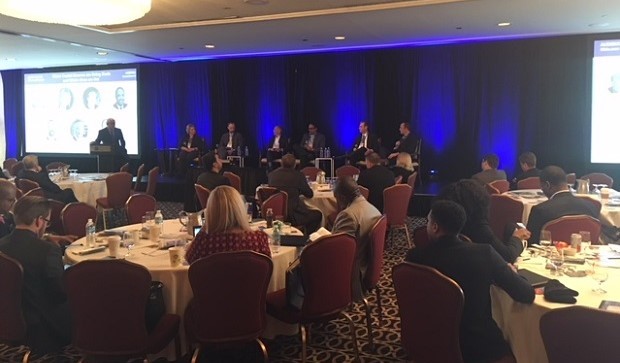 Marcus & Millichap’s Multifamily Forum, held last week at Chicago’s Mid-America Club.
Marcus & Millichap’s Multifamily Forum, held last week at Chicago’s Mid-America Club.
CHICAGO—The tremendous appetite for multifamily properties across the US hasn’t been placated. That was one of the themes of Marcus & Millichap’s Multifamily Forum, held last week at Chicago’s Mid-America Club. But this coming year promises to be at least somewhat complicated, largely due to the expected rise in interest rates, but also due to concerns the US may finally, after one of the longest recoveries in history, finally see the economy plateau or even slip into a bit of a recession.
Richard Katzenstein, senior vice president, Marcus & Millichap, led an afternoon panel on capital sources, and began by asking Mark Stern, principal, Cresset Wealth Management, where he thought the market would see new sources. He strongly feels private investors want to gain access to the type of multifamily properties usually bought and sold by institutional investors. As reported in GlobeSt.com, a Cresset affiliate just completed its acquisition of Wells Place, an 84-unit rental property in the heart of Chicago’s South Loop. This was start of its plan to bring private investment opportunities in the multifamily market to its wealth management clients.
Philip Lukowski, executive vice president and chief portfolio manager for Waterton Associates, pointed out that much of the current demand for multifamily is coming from overseas. He estimated that foreign investors have between $150 billion and $190 billion of “dry powder,” or capital now earmarked for future purchases of US multifamily properties, just sitting around. Furthermore, the rise in the stock market has boosted the value of groups such as pension funds, and as many typically set aside between 15% and 20% of their capital for real estate, many now need to buy more to keep their portfolios properly balanced.
But for all the demand, there did seem to be a bit of a slowdown earlier in the year. Ann Atkinson, director, multifamily customer engagement for Fannie Mae, noted that the agency did about $55 billion in deals during 2016, a number which rose to $67 billion in 2017. But in the first quarter, it totaled about $11 billion, which she termed a slowdown, “but not at an alarming rate.” And it could have been due to “the amount of competition.”
Another factor could have been the boost in interest rates. Atkinson did see signs of some borrowers not pulling the trigger early in the first quarter. That caused the pipeline to back up for a few weeks, but she also says that has cleared up. When it comes to interest rate increases, “borrowers understand it’s here to stay.”
Chuck Meyer, principal, PGIM Real Estate Finance, said whatever slowdown in production that occurred was not that serious. And considering how much people want to help finance multifamily these days, “it’s a good time to be a borrower.”
“We are due for a tap on the brakes,” added Jerry Lumpkins, director, BMO Harris. But the underlying strengths of the sector, plus his organization’s conservative approach to underwriting, means he does not have many worries. “We sleep well at night.”

















 Copyright © 2024 ALM Global, LLC. All Rights Reserved.
Copyright © 2024 ALM Global, LLC. All Rights Reserved.